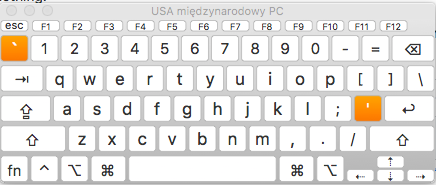If you open on-screen keyboard in OS X, you'll see these two symbols (` and ') are not the same as others. They are used to enter sybmols like á without requirement of holding a button or using an option key. Because of this handling, OS X generates different input sequence to an application while using these keys.
Terminal's input is a text-based, when MacVim (GUI) not in Insert or Replace modes, the input is keypress-based, and it swallowed by OS X.
Try to change a layout to US and check if '> works there. To insert symbols from extended alphabet you can press and hold a button and then select required from a pop-up selection.


I have "U.S. International PC" as Keyboard Input Source which means that to produce ä I need to press " followed by a and to produce an actual double quote I have press " followed by space.
To go to a mark like
'>I can press'<space>>in vim inside iTerm (terminal emulator) and works fine. When I try the same thing in MacVim it doesn't work. MacVim doesn't seem to recognize this while in normal / operator pending mode,So
'<space>>seems to be interpreted (not sure) as :<space>but it it should be interpreted as "jump to end of last visual selection"
If I type just
'>seems to be interpreted as nothing. But the right sequence to type would be'<space>>.Anyway MacVIm doesn seem to be usable with U.S International PC layout, while vim in iTerm works fine.